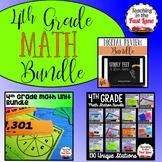4th Grade Math Stations - Math Activities for the Whole Year - Math Games Bundle
- Zip
Products in this Bundle (13)
showing 1-5 of 13 products
Also included in
- This 4th Grade Math Bundle includes unit lesson plans, math stations, and Digital Stinky Feet review games for every unit of the year! TEKS and CCSS aligned this bundle will have your students begging you for more while saving you time! ---------------------------------------------------------------Price $214.95Original Price $339.84Save $124.89
Description
This 4th Grade Math Stations Bundle has everything you need for your students to practice for mastery according to the 4th grade math standards!
------------------------------------------------------
Included in this 4th Grade Math Stations Bundle are thirteen individual sets of math stations. Each individual math station set has ten activities for a fourth grade standard in math. These activities are created entirely in black and white to save on expensive colored ink and meant to target the standard specified to fill in gaps and gather data about student mastery.
------------------------------------------------------
How Do I Use These 4th Grade Math Stations?
- As a partner game or learning center
- For independent assessment
- In a small group led by the teacher
- After school tutoring
- As a school-to-home connection for students to complete with their families
------------------------------------------------------
4th Graade Math Station Topics Include:
- Place Value
- identifying and naming whole numbers to a billion, forms of a number, as well as comparing and ordering numbers
- Decimals and Fractions
- identifying and naming decimals to the hundredths place as well as comparing and ordering decimals
- converting fractions with a ten or hundred in the denominator to decimals and decimals to fractions
- Comparing Fractions
- identifying fractions, composing and decomposing fractions, comparing fractions, and generating equivalent fractions
- Adding and Subtracting Fractions
- represent and solve addition and subtraction of fractions with equal denominators using objects and pictorial models that build to the number line and properties of operations
- Addition and Subtraction
- add and subtract whole numbers and decimals to the hundredths place using the standard algorithm
- Multiplication and Division
- use strategies and algorithms, including the standard algorithm, to multiply up to a four-digit number by a one-digit number and to multiply a two-digit number by a two-digit number. Strategies may include mental math, partial products, and the commutative, associative, and distributive properties
- represent the quotient of up to a four-digit whole number divided by a one-digit whole number using arrays, area models, or equations
- Models and Equations
- represent multi-step problems involving the four operations with whole numbers using strip diagrams and equations with a letter standing for the unknown quantity
- Input-Output Tables and Numerical Patterns
- represent problems using an input-output table and numerical expressions to generate a number pattern that follows a given rule representing the relationship of the values in the resulting sequence and their position in the sequence
- Perimeter and Area
- solve problems related to perimeter and area of rectangles where dimensions are whole numbers
- Geometry
- identify points, lines, line segments, rays, angles, and perpendicular and parallel lines; identify and draw one or more lines of symmetry, if they exist, for a two-dimensional figure; apply knowledge of right angles to identify acute, right, and obtuse triangles; and classify two-dimensional figures based on the presence or absence of parallel or perpendicular lines or the presence or absence of angles of a specified size
- Measuring Angles
- determine the approximate measures of angles in degrees to the nearest whole number using a protractor; draw an angle with a given measure; and determine the measure of an unknown angle formed by two non-overlapping adjacent angles given one or both angle measures
- Measurement
- identify relative sizes of measurement units within the customary and metric systems; convert measurements within the same measurement system, customary or metric, from a smaller unit into a larger unit or a larger unit into a smaller unit when given other equivalent measures represented in a table; and solve problems that deal with measurements of length, intervals of time, liquid volumes, mass, and money using addition, subtraction, multiplication, or division as appropriate.
- Data and Graphs
- represent data on a frequency table, dot plot, or stem-and-leaf plot marked with whole numbers and fractions; and solve one- and two-step problems using data in whole number, decimal, and fraction form in a frequency table, dot plot, or stem-and-leaf plot.
------------------------------------------------------
Please check out each of the individual products for more specific descriptions and product previews.
------------------------------------------------------
For more test prep check out my Test Smash series:






